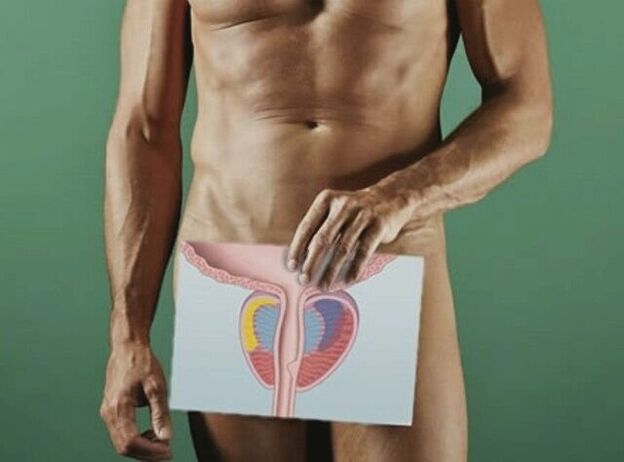
The term "prostatitis (microbial code 10 - 41)" refers to inflammatory processes that occur in the tissues of the prostate, and lead to pain, difficulty urinating, frequent urge to go to the toilet, decreased libido. According to various statistics, the disease mainly affects men of reproductive age, ie from twenty-five to fifty years. Depending on the characteristics of the symptom complex and the degree of gland damage, two forms of prostatitis are distinguished - acute and chronic.
According to the MCB coding, prostatitis in the chronic form is assigned a value of 41, 1, and for the acute form the code 41, 0 is used. The primary diagnosis is made by visual examination of the patient and study of the anamnesis. Additional techniques are used for confirmation: ultrasound and laboratory methods.
General characteristics and classification
Every third representative of the strong half of humanity knows what prostatitis is, which occurs in various forms, because this disease, caused by inflammation of the prostate, is one of the most common pathologies of the male genital area. The disease is manifested by characteristic symptoms: pain, tingling, increased urination, decreased sexual activity, frequent desire to go to the toilet.
Prostatitis in men is a consequence of the defeat of the prostate by infectious agents that penetrate its tissues through the reproductive organs or systemic circulation. Even reasons like the common cold or bronchitis can cause an inflammatory process. This most often occurs against the background of factors favorable for the spread of infection, among which is primarily called weakened immunity.
To get average indicators, there is a statistical coding of prostatitis mkb 10, which allows you to objectively assess the situation in terms of the incidence of the male half of the population. Chronic prostatitis mkb 10 has a code of 41. 1, which is attributed to a disease that lasts for six months or more. In addition, the classification of the international code ICB 10 xp prostatitis characterizes this form of the disease as difficult to treat.
In acute prostatitis mkb 10 was assigned a slightly different - 41. 0. This form of the disease is recognized as a well-tolerated therapy that is used and runs in the background of pronounced symptoms of the disease. There is also a code 41. 2. This indicator is common to indicate diseases associated with the formation of prostate abscesses. It is important to know that the diagnosis of chronic prostatitis recommends that a man undergo treatment at least once every six months and visit specialists regularly.
Predisposing factors
The likelihood of acute and chronic prostatitis in men increases significantly against the background of the negative effects of predisposing factors. The following reasons can become a kind of catalyst for inflammatory processes affecting prostate tissue:
- Occurrences of stagnation, which are characterized by impaired blood flow, and occur in the background of a sedentary lifestyle, low sexual activity, overweight.
- Systematic hypothermia of the body, caused, for example, by the peculiarities of work.
- Injuries, regardless of their nature and the time that has elapsed since the moment of injury.
- Infectious, viral diseases of the genital area, including sexually transmitted diseases.
- Infectious and inflammatory diseases of other systems and organs, for example, bronchitis, purulent tonsillitis and others.
As an additional predisposing factor, practical medicine mentions digestive problems, expressed in the appearance of systematic constipation. Therefore, an inappropriate approach to diet can indirectly affect the development of prostatitis.
Bitan! Timely elimination or reduction of the influence of negative factors is the most reasonable and most effective method of preventing prostatitis in men.
Clinical picture
Probably many people know what prostatitis of various forms is. But not everyone is aware that the classic signs of this unpleasant disease can change significantly depending on the stage and form of the pathology:
- Catarrhal prostatitis. The disease is characterized by the appearance of pain in the perineum, groin, frequent urge to go to the toilet.
- Follicular prostatitis. The pain syndrome becomes more intense, there are difficulties with urination, and there may be a false desire to go to the toilet.
- Parenchymal prostatitis. Severe pain syndrome, aggravated by the act of urination or defecation, often there is a delay in the flow of urine, false desire to go to the toilet, high fever, chills, weakness, fatigue.
The course of chronic prostatitis is accompanied by the appearance of almost all of the above signs, however, the symptoms become more worn out. It should be emphasized that the acquisition of a chronic form of the disease is quite rare in the background of exacerbations. In general, this form of the disease in men develops gradually, under the influence of inflammatory processes arising from infectious lesions of prostate tissue. Its main symptoms are:

- Disuric syndrome. Against the background of the negative impact of inflammatory processes, the prostate significantly increases in volume, which leads to compression of the ureter. This pathology is the main reason for the appearance of frequent urges to urinate, including false, painful sensations.
- Pain syndrome. The prostate itself is deprived of nerve endings, that is, painful sensations in prostatitis are a consequence of the spread of inflammatory processes and damage to nerve fibers along the prostate of the pelvic organs.
- Sexual dysfunction. Prostate diseases are characterized by the appearance of various disorders of a sexual nature. Most men complain of a decrease in the intensity and brightness of sensations gained during intercourse; in the early stages of the disease, a decrease in libido and lack of erection is possible. Impotence is characteristic of advanced forms of pathology.
You need to know that the development of prostatitis is often accompanied by disorders in the patient's psycho-emotional background. The person becomes more irritable, it is possible to develop depressive states, nervous breakdowns.
Prostatitis is associated with a characteristic clinical picture, which greatly facilitates timely diagnosis. The main diagnostic methods are rectal examination performed by a specialist by hand, ultrasound examination, as well as collection of urine and prostate secretions for analysis in the laboratory.
Methods of treatment
How to treat prostatitis, which methods will be most appropriate in a particular clinical case, is determined exclusively by the physician, based on research results, physiological characteristics of the patient, form and stage of disease development. The most commonly used methods of complex therapy, including medication, physiotherapy methods, folk remedies, as well as dietary correction.
Treatment of the chronic form
Chronic prostatitis is a particularly unpleasant disease, its treatment is fraught with a number of problems and difficulties, it is almost impossible to completely eliminate the disease. However, the use of competent therapy will enable the achievement of long-term and stable remission, as well as the elimination of the main symptoms of the disease and a significant improvement in the quality of life. The main methods of treatment are:
- Treatment. The selection of drugs is carried out according to an individually developed scheme by experts, mainly antibacterial and anti-inflammatory drugs are used. To eliminate pain in the early stages of treatment, it is allowed to use painkillers.
- Physiotherapy. To stimulate regenerative processes and increase the effectiveness of the active components of drugs, in addition to drugs, physiotherapeutic methods are used, such as, for example, laser therapy, magnetotherapy, electrophoresis.
- Massage. One of the most effective methods of treating prostatitis, regardless of its shape and stage, is prostate massage. The procedure helps to alleviate inflammation, eliminate stagnation and pain. As a rule, the massage is performed by a specialist in a medical institution, however, with the obligatory mastery of medical techniques, you are allowed to perform it yourself at home.
- Immunomodulatory therapy. Therapy of chronic prostatitis involves the mandatory intake of immunomodulatory drugs that increase the immune system and general tone of the body. To eliminate this unpleasant disease, the choice of drugs should be based on doctor's prescriptions.
In addition, treatment involves the obligatory rejection of the patient from existing bad habits, correction of diet and daily routine. Including a range of products enriched with vitamins and beneficial micronutrients in the usual menu will help strengthen the body. Moderate physical activity is also an important measure. Physical activity will help avoid stagnation and normalize blood and lymph flow.
Bitan! Treatment of prostatitis can be carried out only under the supervision of a specialist. Self-medication or the use of other techniques can lead to negative consequences and worsening of the patient's condition.
Treatment during exacerbation
Competent treatment of acute prostatitis, with timely application of adequate therapy, allows you to completely get rid of the disease and normalize prostate function. It is important to know that this form of the disease tends to become chronic, and therefore treatment should be carried out when the primary symptoms appear.
Treatment of prostatitis in the acute phase involves the use of drugs with antibacterial and anti-inflammatory properties. In addition, physiotherapy methods, massage, gentle diet can be used. If the disease takes place against the background of the formation of purulent abscesses, it is necessary to use surgical intervention aimed at opening the capsule, removing the purulent masses and removing the foci of inflammation.
Possible complications
Lack of treatment for both acute and chronic forms of prostatitis can lead to the development of complications. In the background of the course of inflammatory processes in the form of exacerbation, there is a risk of the formation of purulent abscesses in the tissues of the prostate, or a type of capsule filled with purulent contents. The patient's condition in such a situation suddenly deteriorates, there is a delay in the outflow of urine, intense pain syndrome, high fever, chills.
The most common complications of chronic prostatitis include the risk of developing inflammatory processes affecting the tissues of the bladder and genitals. In addition, in the vast majority of cases, the disease is accompanied by sexual dysfunction, leads to decreased libido, various disorders of the reproductive system, and in the most severe cases - to impotence. It is almost impossible to completely cure such pathologies.
In order to cure the disease, prevent complications and the development of chronic or advanced prostatitis, it is important to take the necessary measures in a timely manner. Specialists should be consulted to determine the causes of discomfort and prescribe adequate therapy when the first symptoms of the disease appear. Ignorance of the first alarm bells and missing the necessary time leads to serious complications of the disease.






























